Do you want to auto generate SEO content for 404 WordPress URLs? If you are looking for a simple guide, keep reading this post.
If your WordPress site is getting referral traffic from ChatGPT, Claude, or other AI chatbots, but users land on 404 pages, you’re not alone.
These tools often generate links that never existed or were removed, leading to broken visits and missed SEO opportunities.
But instead of letting that traffic go to waste, you can turn those 404s into valuable SEO optimized content automatically. In this post, you’ll learn how to track AI-generated 404s and use a smart automation flow to generate content dynamically.
We’ll also introduce the LLM URL Solution, an open-source tool that helps you turn chatbot traffic into real search value.
First, let’s see what is causing AI bots to link to 404 pages.
Table of Contents
What’s Causing AI Bots to Link to 404 Pages?
AI chatbots, such as ChatGPT and Claude, are trained on vast amounts of web data.
During conversations, they often suggest URLs as sources or examples, based on the structure of real websites.
However, these links are not always verified in real time. As a result, many of the URLs they generate either never existed or were removed long ago. When users click on these AI-suggested links, they are redirected to 404 error pages.
Over time, this creates a noticeable spike in broken traffic, especially from domains like chat.openai.com. These visits may look like organic traffic, but they don’t convert or help your SEO unless you take action to repurpose them.
Why You Should Turn AI Bot 404s Into SEO Content
When visitors land on 404 pages from AI chatbot referrals, it’s a missed opportunity. These users are actively looking for answers or content that your site appears to offer.
By automatically generating SEO-optimized pages for these URLs, you can convert broken traffic into long-tail search value. This strategy helps reduce bounce rates, improves user experience, and increases your site’s relevance in search results.
Instead of showing a dead end, your site responds with helpful content, boosting both engagement and SEO performance. It’s also a smart way to future-proof your site as AI-generated traffic continues to grow.
Converting 404 errors into live, applicable content keeps your site competitive in this new referral landscape.
How to Track AI Bot-Generated 404 Pages
Before you can turn 404 errors into SEO content, you need to know which pages are being hit—and where the traffic is coming from. Here are some practical ways to track AI-generated 404 visits:
- Google Analytics 4 – Use the Pages report and filter for /404 or set up custom events to track 404 pageviews.
- 404 Monitoring Plugins – Use tools like Rank Math’s 404 Monitor or Redirection to log missing URLs directly in your WordPress dashboard.
- Server Logs or Hosting Analytics – Advanced users can track 404 status codes from raw access logs.
Next, let’s see how to auto generate SEO content for WordPress URLs.
How to Auto Generate SEO Content for 404 WordPress URLs
To achieve this, you need to work with APIs, webhooks, and other related technologies. But there is a simple method. Very Good Plugins developed an open-source tool that will help you achieve this task.
For this tutorial, we will be using this tool. The first step is to open the GitHub link and download the plugin files.
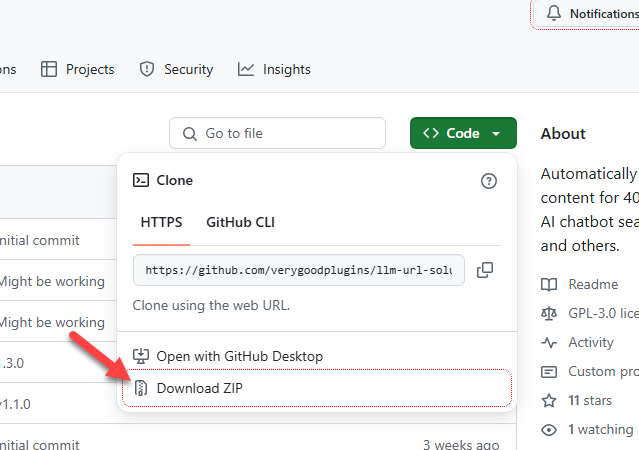
Next, you need to install and activate this plugin on your WordPress website.
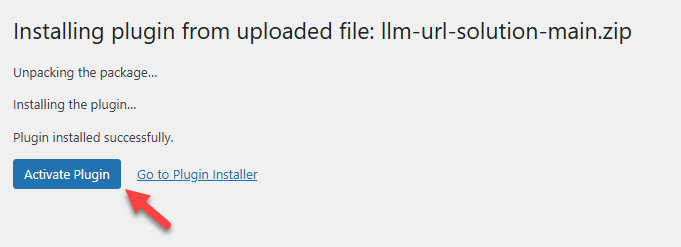
After activation, you can see the plugin’s settings on the left-hand side of the WordPress dashboard.
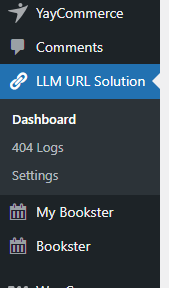
Now open the settings page. That’s where you need to enter the API key of OpenAI.
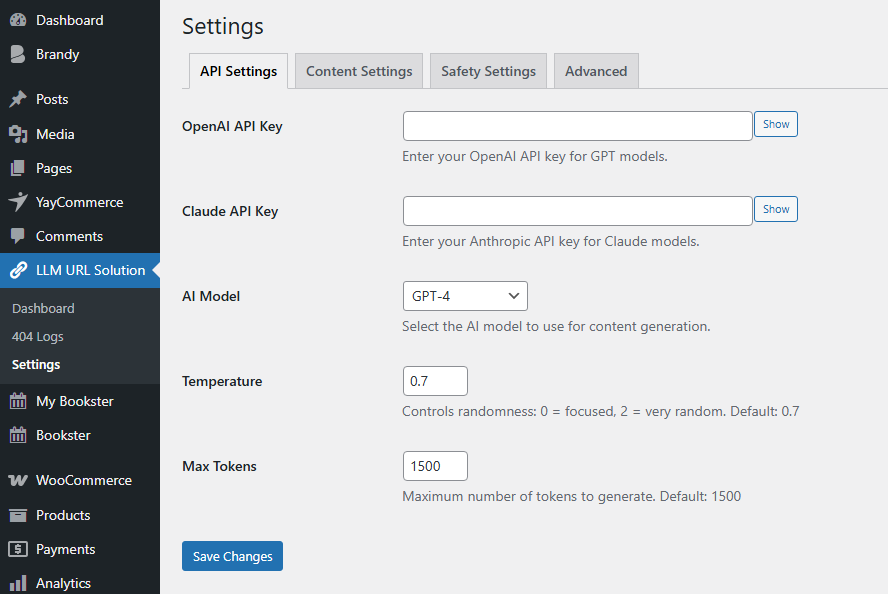
To get the API key, you need to go to the OpenAI API page. From there, you can create/edit the API keys.

Setting up an API key is simple. All you need to do is click the ‘Create New Secret Key’ button and name your key. Also, choose a project if you have multiple projects going on.
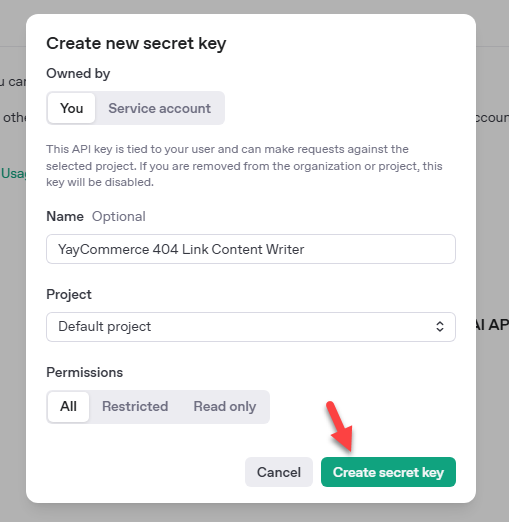
Now, copy your secret key.
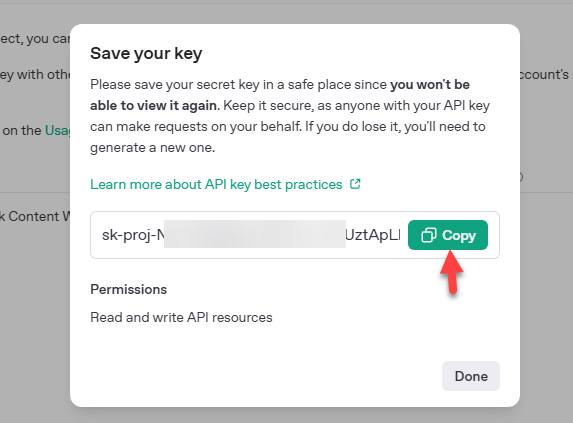
Now, go to the LLM plugin settings and paste the API key. Once you have done that, save the plugin’s settings.
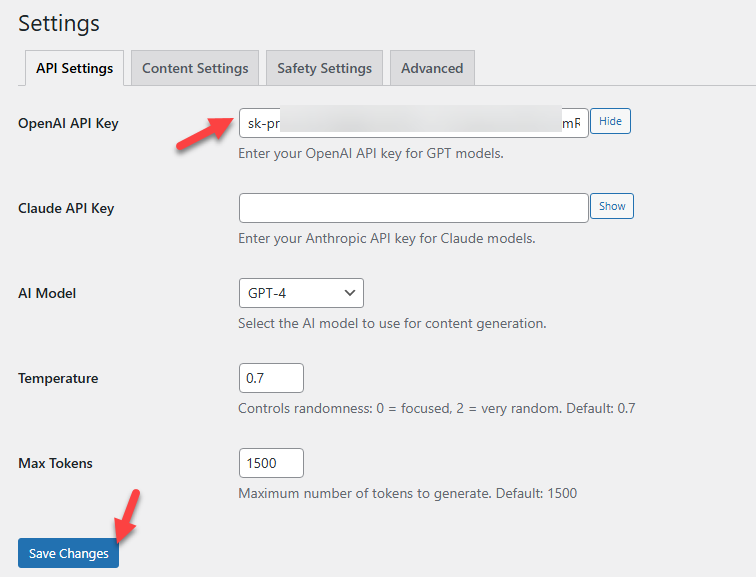
You’re now halfway done. If you check the remaining settings on the page, you can see that you will need to choose
- An AI model
- Temperature
- Max tokens
And so on. The default values are good enough. However, if you need to, you can tweak the AI model slightly and choose any other version of GPT. Once you are done with that option, move to the content settings.
Here, you can choose the generated content.
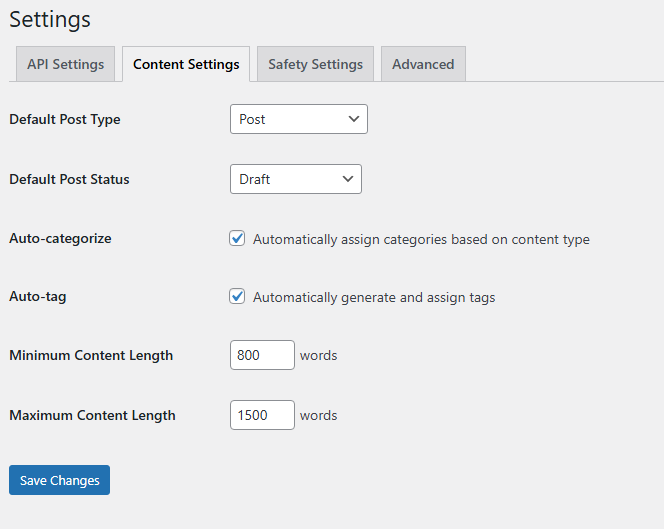
The configuration options available are:
- Default post type: Post
- Default post status: Draft/Published. If you need to review the post before publishing, use the draft. Otherwise, publish the article directly.
- Auto-categorize: yes
- Auto tag: yes
- Min content length: 1000
- Max content length: 1800
Tweak the options accordingly and move to the next option. There, you will see the safety settings.
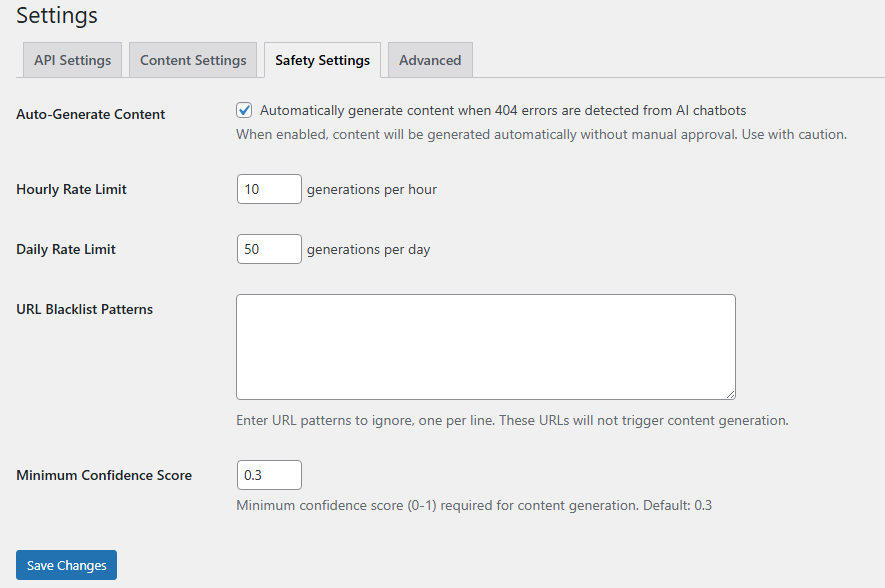
Ensure that the Auto Generate Content option is enabled. Additionally, set the hourly and daily limits. This will help keep the API usage under control. Once you have completed this step, proceed to the advanced settings.
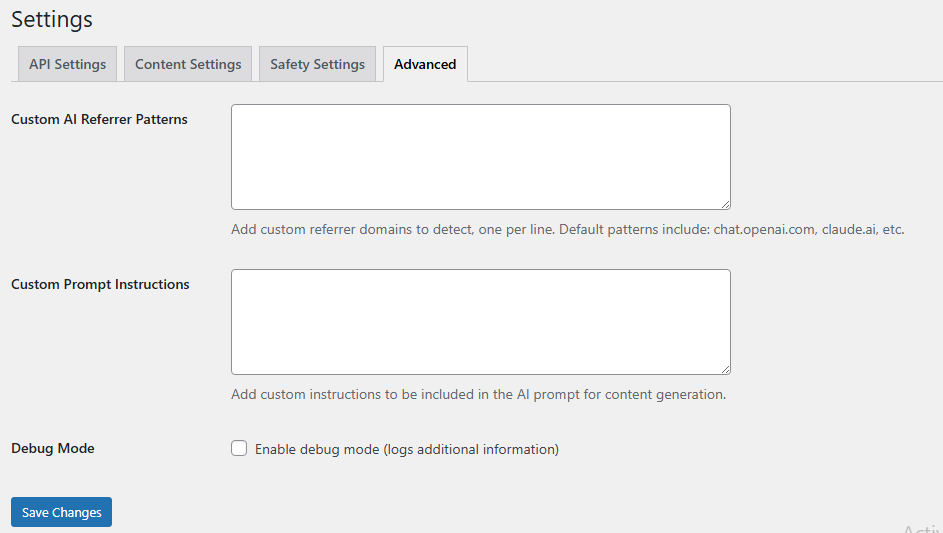
If you need to add custom AI referrer patterns or prompt instructions for the generated content, use this section. After configuring the plugin settings, you are done.
From now on, whenever someone lands on your website from an AI bot suggestion/answer and the link pointed to is a 404 URL, the plugin will take care of it.
It will automatically generate a description/blog post for the selected content. Under the 404 logs section, you can see all the 404 links. From the same page, you can also see if the plugin generated content for the 404 link or not.
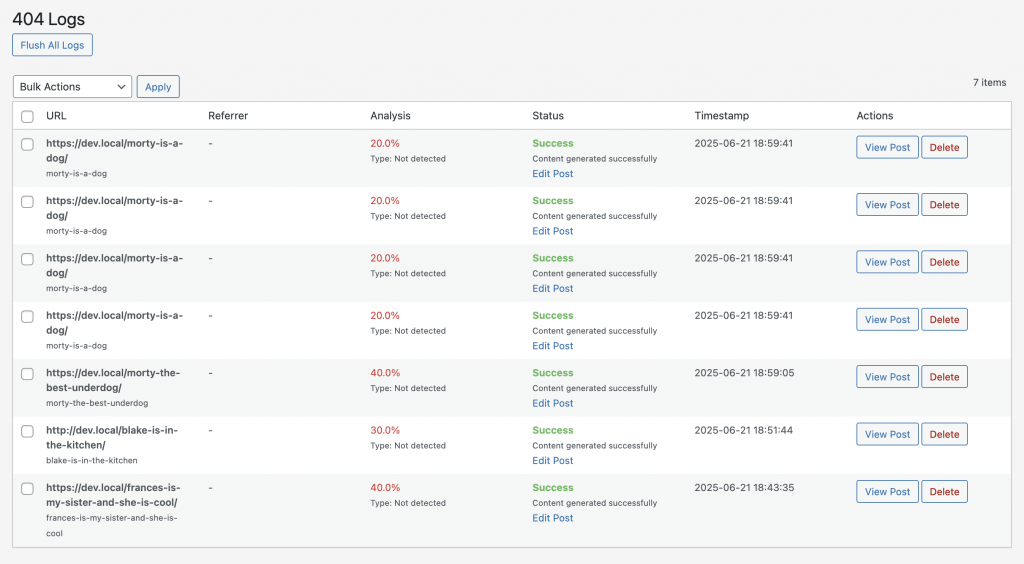
That’s it!
This is how you can auto generate SEO content for 404 WordPress URLs.
Hooks and Filters Available
If you are a developer and need to add custom functions to the plugin, you can use these hooks and filters:
llm_url_solution_404_logged– Fired when a 404 is loggedllm_url_solution_content_generated– Fired after content generationllm_url_solution_is_ai_referrer– Customize AI referrer detectionllm_url_solution_is_blacklisted– Customize URL blacklistingllm_url_solution_generation_context– Modify content generation contextllm_url_solution_ai_prompt– Customize AI prompt
And here is a sample code:
// Add custom AI referrer pattern
add_filter('llm_url_solution_is_ai_referrer', function($is_ai, $referrer) {
if (strpos($referrer, 'mycustombot.com') !== false) {
return true;
}
return $is_ai;
}, 10, 2);
// Modify content generation context
add_filter('llm_url_solution_generation_context', function($context, $analysis) {
$context['custom_instructions'] .= ' Always mention our brand name.';
return $context;
}, 10, 2);Frequently Asked Questions
Next, let’s see some frequently asked questions regarding this topic.
What are AI chatbot-generated 404 pages?
These are pages users try to visit after clicking links suggested by AI tools like ChatGPT or Claude. Often, these links point to URLs that never existed or have been removed, resulting in 404 errors.
Can AI referral traffic help with SEO?
Yes, if handled correctly. By turning those broken visits into useful, optimized content, you can capture long-tail traffic, lower bounce rates, and improve your site’s relevance in search engines.
How can I identify which 404 errors are caused by AI bots?
Look at your referrer data in analytics tools. Sources like chat.openai.com or claude.ai often indicate that the 404 came from an AI-generated suggestion.
Do I need coding skills to automate content for 404s?
Not necessarily. You can use tools like WP Webhooks or the open-source LLM URL Solution to automate the process with minimal technical setup.
Should I redirect users or create new content for 404s?
Redirects are helpful if a relevant page already exists. However, if the topic is new or specific, generating SEO-optimized content for that 404 URL can provide better long-term value.
Conclusion
As AI chatbots like ChatGPT and Claude become more common referral sources, they are reshaping how visitors land on your WordPress site.
However, when those visits result in 404 pages, it is not a dead end. It is a new opportunity. By tracking AI-generated 404 errors and converting them into SEO-optimized content, you can reclaim lost traffic, enhance your search visibility, and provide a better experience for your visitors.
Tools like LLM URL Solution make it easy to automate this workflow and keep your site relevant in the age of AI. If your site is experiencing unexplained 404 errors from AI bots, now is the time to take action.
Utilize that traffic to your advantage and transform broken links into high-ranking content.
Would you add this feature to your WordPress website/
Let us know in the comments.
